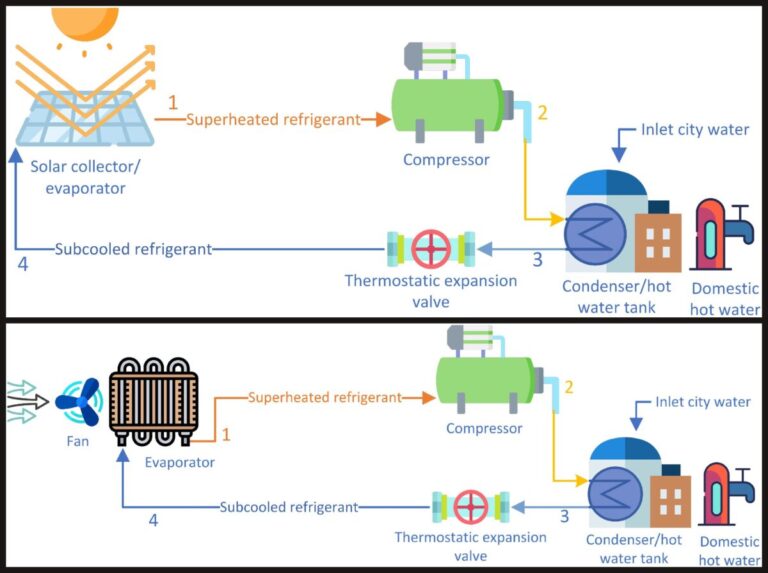A group of researchers in Iran analyzed the coefficient of performance and energy consumption of solar and air source heat pumps and found that three factors are crucial to determine their annual performance: changes in irradiation, ambient temperature, and wind speed.
An international group of scientists conducted a year-long comparative analysis of two types of heat pumps for water heating: solar-assisted direct expansion heat pumps (DX-SAHPWHs) and air source heat pumps (AHPWHs). Both systems were examined via numerical models, assuming they were deployed with identical parameters in Tehran, the capital of Iran.
“To make those water heaters comparable, it is assumed that all design parameters for both heat pumps are the same with identical components,” the research group said. “For the solar hot water system, the evaporator is the flat plate solar thermal collector, while for the air heat pump water heater, the evaporator is a low temperature liquid-air heat exchanger with the same surface area and configuration as the unglazed solar collector, but the plate is made of removed from above.”
The thermal collector and liquid-air heat exchanger were assumed to have an area of 4.21 m2. In the case of the DX-SAHPWH, the condenser consists of a 60 meter long copper tube immersed in the domestic hot water tank and acting as a thermosiphon heat exchanger. The selected working fluid is R-134a.
“In the formulation of the air source heat pump water heater, the thermodynamic relationships for both the components and the parameters are the same as those of the solar assisted heat pump,” the academics added. “Only the evaporator equation needs to be adjusted, assuming the fan speed is 10 m/s.”
By modeling the two systems, the researchers calculated their monthly coefficient of performance (COP) and electricity consumption over a twelve-month period. For each month they used as input the average daily data on cloud factor, horizontal radiation, ambient temperature and wind speed. The intended hot water in all cases was 50 C, 60 C and 70 C.
“Comparison of the COP between these systems for all three hot water temperatures for all months shows that there is less than 0.1 difference in COP,” the results showed. “In other words, both systems perform virtually the same during different seasons and require water temperatures. For both systems, COP has the lowest value of 2.0 in the coldest month of January, and the highest value of 2.8 in the warmest month of August. The DX-SAHPWH system works with a slightly better COP in all months compared to the AHPWH system.”
In terms of electricity consumption, the analysis showed that both systems consume almost the same electricity during different seasons and different water temperature requirements. “For both systems, the energy consumption has the lowest value of 3,850 MJ in the coldest month of January, and the highest value of 4,900 MJ in the warmest month of August. The DX-SAHPWH system consumes slightly less electricity compared to the AHPWH system in some months, while in other months it is the opposite,” they said.
By conducting a sensitivity analysis, the scientific group found that when irradiance doubles from 500 W/m2 to 1,000 W/m2, solar heat gain increases by 49% in the DX-SAHPWH for hot water with a temperature of 50 C. Also for With the same increase in irradiation and the same water temperature, the evaporator temperature increases by 55% from 22.32 C to 34.65 C.
“As weather conditions in terms of irradiation and ambient temperature change throughout the year, the performance of the DX-SAHPWH changes dramatically for most operating parameters,” she added. “For example, the difference in evaporator temperature between January and August is 21.8 C (from 4.9 C to 26.7 C) at a hot water temperature of 50 C. Similarly, the compressor power varies between 2,850 and 5,868 MJ per year, or a change of 106%. However, the COP showed less variation between different months as it ranges between 2.04 and 2.79 for a water tank at 50 C.”
Concluding their research, the academics said that for lower temperatures and higher levels of solar radiation, the DX-SAHPWH is recommended. However, they noted that AHPWH works more efficiently at higher temperatures and lower radiation.
Their findings were presented in the article “Annual comparative performance of solar and direct expansion air source heat pumps for residential water heating”, published in the International Journal of Thermofluids. The research was conducted by scientists from Ireland’s University College Dublin, the MaREI Center for Energy, China’s China University of Petroleum and Rice University in the United States.
This content is copyrighted and may not be reused. If you would like to collaborate with us and reuse some of our content, please contact: editors@pv-magazine.com.


